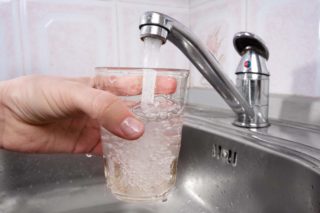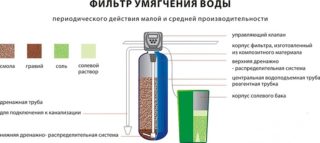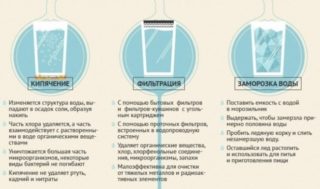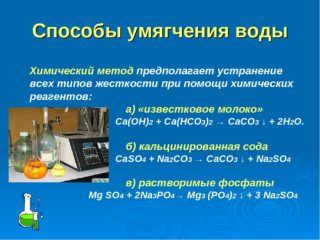In most cities, the hardness of tap water is simply off scale, which negatively affects human health and the operation of household appliances. The level of water hardness depends on the concentration of minerals and salts in it. Different indicators are observed in the regions of the country. There are several effective ways that make water softer, but some retain its beneficial properties, while others make it unusable.
Why do you need water softening

Using hard water for food and household purposes, soon scale forms on the walls of appliances and utensils, which are solid deposits of salts and minerals. Most often, it is contemplated on gas boilers, washing machines and parts of an electric kettle.
Scale formation negatively affects the performance and power of household appliances, and soon they may even fail. The water softening system for an apartment and country houses allows you to reduce its hardness. It is especially important to install filter systems in rooms equipped with autonomous heating.
With regular use of tap water, white flakes will soon form on plumbing fixtures. Clean the surface of a bathtub, toilet, sink, bidet, etc. extremely difficult. To get rid of plaque, you need to purchase special household chemicals designed for a specific material. Detergents with a high-quality composition cost a lot of money. It is more profitable to spend money once and install, for example, a filter on the shower to soften the water than to regularly buy store products.
With regard to health effects, water with a high degree of hardness is not easily washed off with detergents such as soap. In addition, after it there is a feeling of "tightness" of the skin.
A high concentration of salts contributes to the formation of sand in the kidneys and the deposition of tartar; diseases of the genitourinary system are more often diagnosed.
Such a liquid increases the consumption of detergents and household products, which negatively affects the family budget.
There are several ways to soften water from the main water supply at home: install special purifying filters, for example, Barrier or Aquaphor; resort to physical methods; add reagents (chemical reaction).
Cleaning filters
The most budgetary and least productive is a jug type filter. It is a small container made of quality plastic and equipped with multilayer cartridges that need to be replaced regularly. With their help, only water molecules can pass through. Salts, minerals and other particles of dirt do not penetrate.
Using the unit is extremely simple: just pour tap liquid into the upper compartment and wait until it drops down. Typically, it takes no more than 10 minutes to cleanse 2 liters of water. The main disadvantages of this type are:
- The need to regularly change cartridges for new ones (the optimal frequency is 1-2 months).
- A limited amount of water is softened.
There are several more types of filters and whole cleaning systems. The most popular among them on the Russian market:
- Ion exchange filter - a reservoir filled with brine, crystals or resin. Previously ionized liquid softens, as a result of which salts and minerals precipitate. Such systems must be installed on pre-cleaned water pipes at the entrance to the apartment or in front of household appliances, bathroom or kitchen.
- Reverse osmosis systems consist of two tanks with a membrane through which tap water penetrates under high pressure. After purification, a person is provided with distilled water suitable for consumption. However, experts recommend not to abuse it, since it is devoid of everything useful.
- The magnetic filter is equipped with two powerful magnets, which are installed at the inlet of the water supply to the apartment. The efficiency of the device is due to the ability of magnets to change the structure of water at the molecular level. Unfortunately, there are no studies on how it affects human health.
The cost of water softeners varies widely. The starting price for jug-type filters is 350-500 rubles.
Physical methods of softening
- boiling;
- freezing;
- upholding.
In the first case, an increase in temperature contributes to the destruction of mineral salts, which precipitate. The cleaning algorithm is as follows:
- Pour liquid into a small metal container and place on the stove.
- After boiling, heat over low heat for at least half an hour.
- The reservoir is covered with a lid and set aside for a day.
After 24 hours, the upper part (it is covered, as a rule, with a translucent film) is drained. Despite the simplicity of implementation, this method of liquid softening has significant disadvantages:
- scale forms on the walls of the dishes;
- the process takes a lot of time;
- after heat treatment, the water has an unpleasant taste;
- High temperatures kill nutrients and oxygen in the liquid.
With the regular use of such water in people, the work of the digestive tract can be disrupted.
The next way that deserves attention is defending. The method is simple to implement, but such a liquid is suitable only for technical purposes. Softening algorithm:
- Pour running liquid into a container.
- Cover with a lid, but not airtight, so that dust and dirt do not get inside, and oxygen can penetrate freely.
- Without stirring, stand for 4-6 days.
Freezing is an unusual method, but effective. Algorithm for the implementation of the softening method:
- Collect water in a transparent tank.
- Put it in the freezer or take it outside if the temperature is below freezing.
- When approximately 75% of the liquid has turned into ice, the remainder of the unfrozen water is discarded.
After the ice has thawed, the water is suitable for drinking, bathing newborns, etc.
It is worth mentioning the use of reagents, for example, baking soda, laundry soap, etc. After the application of chemicals, the water is usually not potable.
Which softening method to use depends on the end goals. For example, if water needs to be softened for cooking and just drinking, it is preferable to install special treatment systems or freeze. If the volume of fluid consumed is large on a regular basis, filters should again be preferred.











